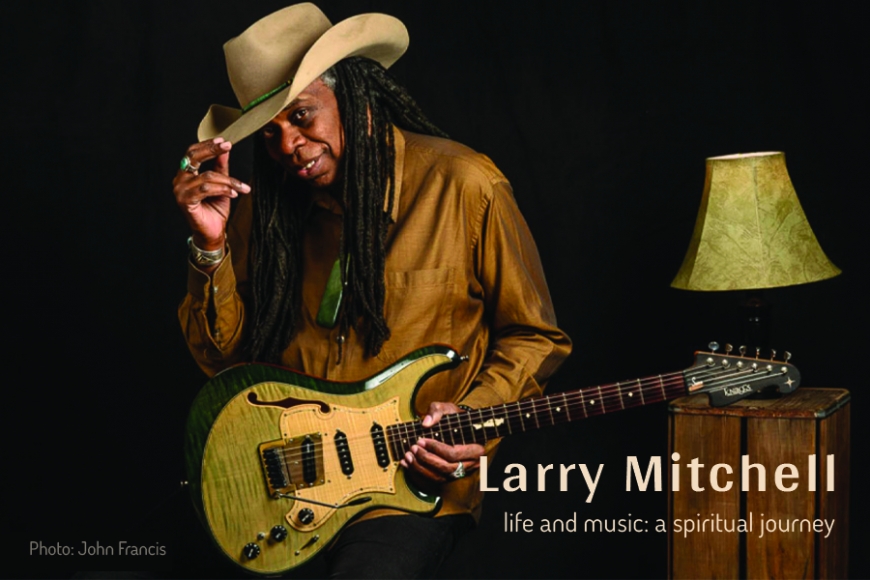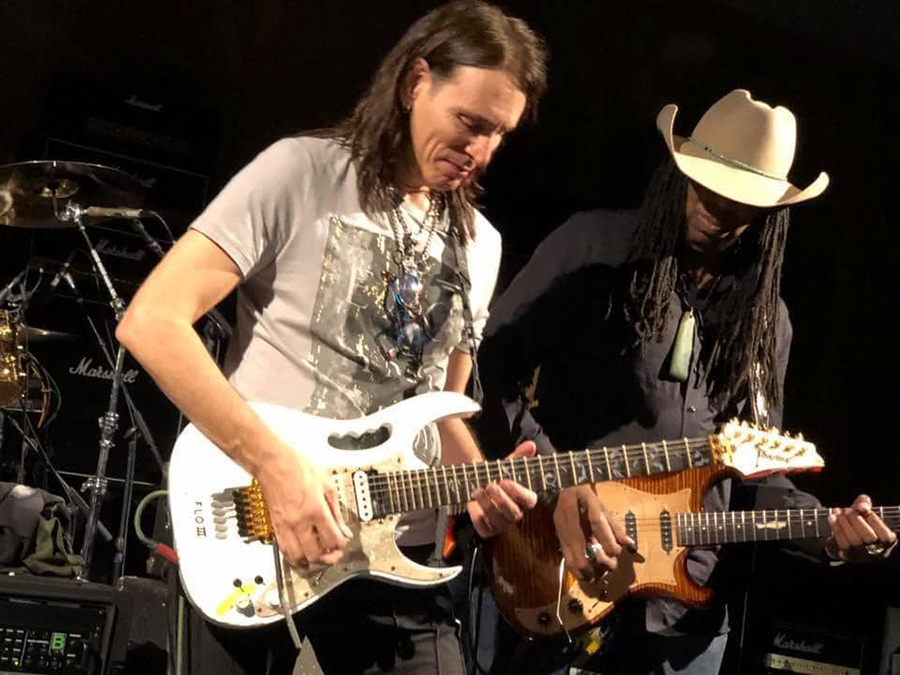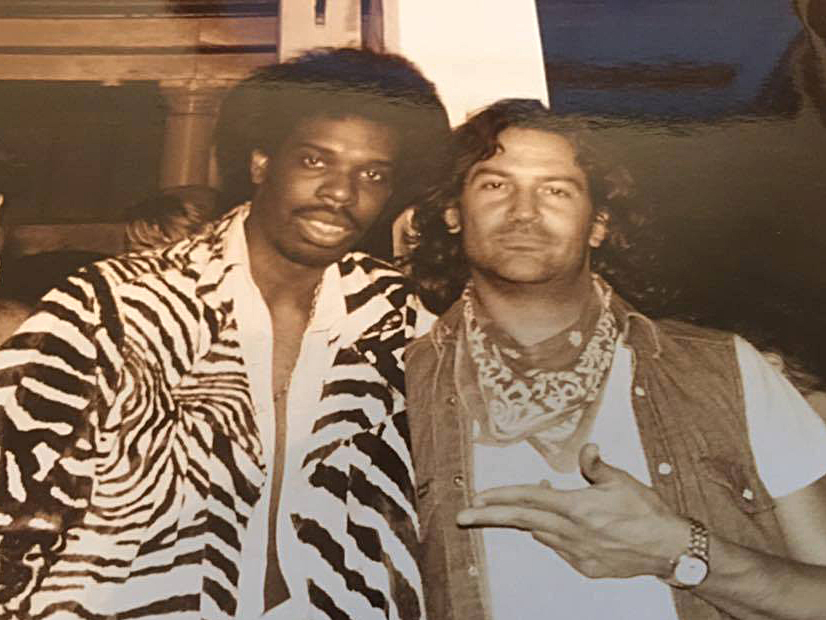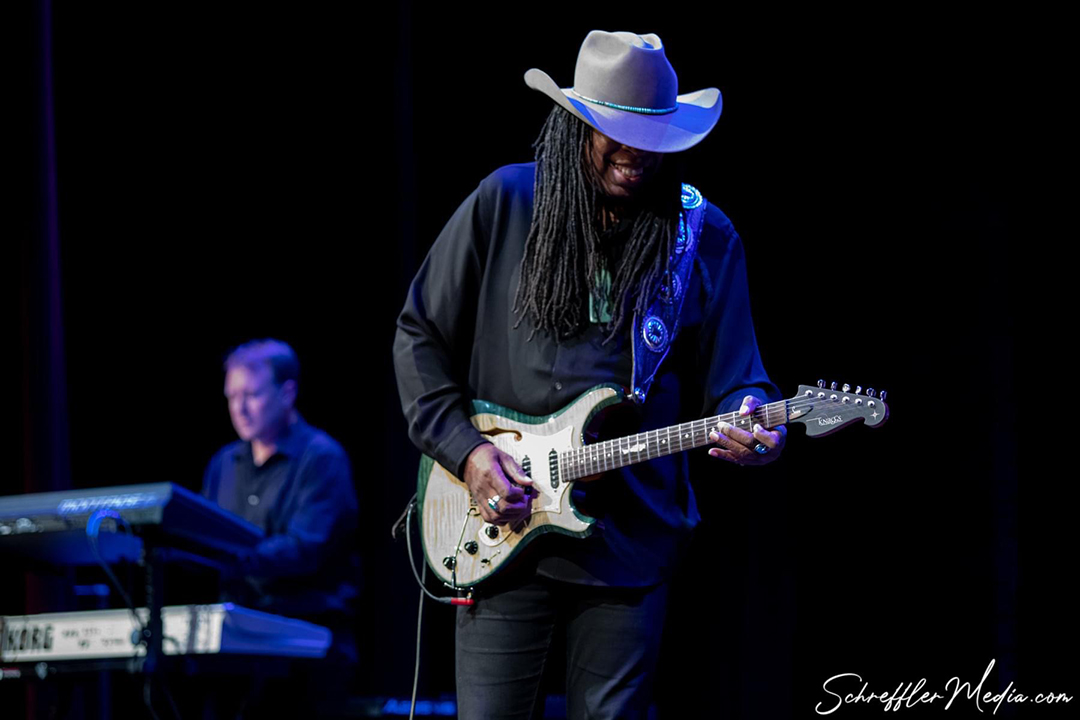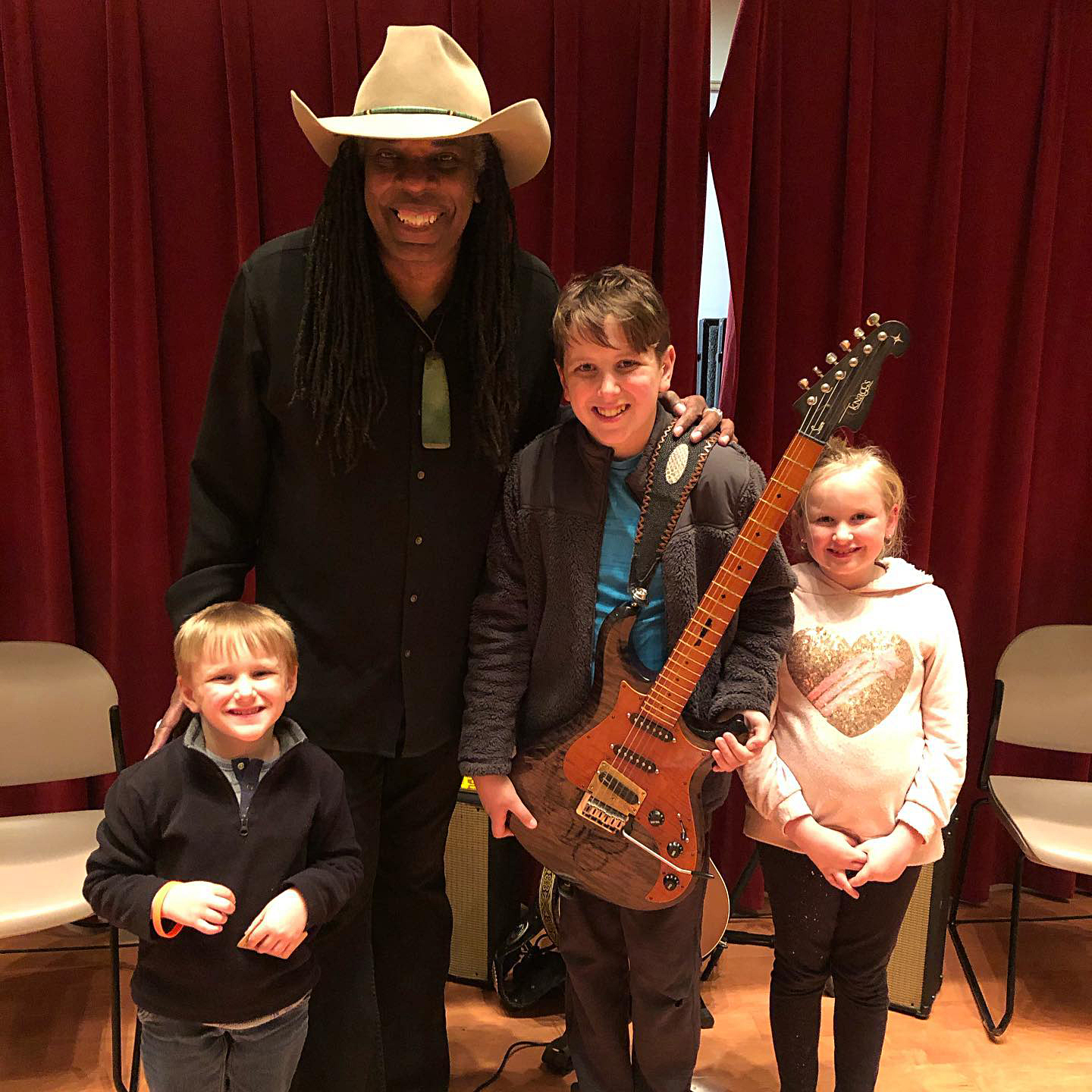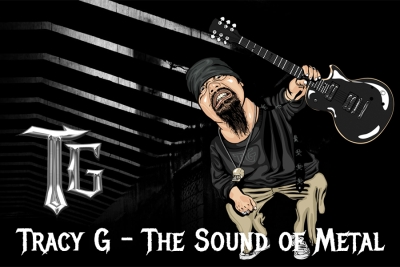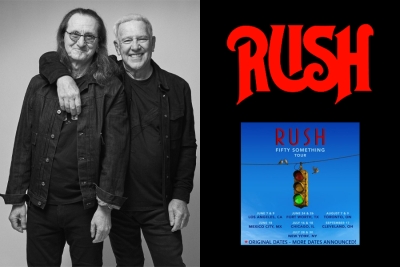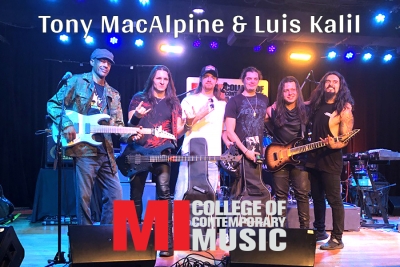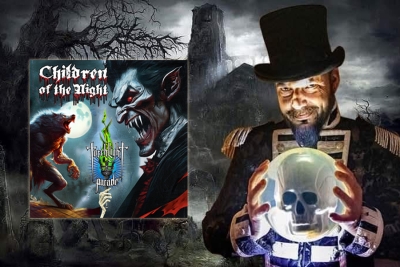In this exclusive interview, Larry Mitchell tells the story of his life-long artistic path, exploring his music and creative inspirations, his innovative approach to guitar playing, and his thoughts on the evolving landscape of the music industry. Join us as we uncover the story of a true musical maverick who continues to push the boundaries of creativity and expression.
Please welcome Larry Mitchell, an exceptionally spiritual human being and inspirational artist who shares with us his sense and resonance of life and his traveler’s view of the world and people in it. His music, recorded or performed live, creates an immersive atmosphere through emotional soundscapes that emit the radiance of the light within.
GA: Larry, you grew up in New York City in the 70’s and for us, who grew up behind the “Iron Curtain”, the image of New York City was associated either with a concrete jungle infected with crime or with a capital of the world, music and cultural mecca at the same time. How was it in real life and how that great city, its vibrant culture, especially its music scene, shaped your artistic personality and influenced you as a musician?
LM: I was born in 1964, so in the ‘70s, I was really young, and in 1974, we moved from Brooklyn to Queens, still part of New York City. However, I really did not start going into the city to play until 1983 – 1984, and there was a crime and it was a little intimidating at first, but it was a wonderful place music-wise. I think about some of the relationships I built with musicians at that time that I’m still friends with, and they're playing all over the world. There are some of what the world calls the best players with the best attitudes.
There is a thing that happened that I took for granted and then didn't realize until I moved away from New York City. First of all, you have people from all over the world there, especially in every ethnic group and nationality. And in music, I don't know how it was with the rest of the type of arts and stuff like that, but in music most people were there for the music. So if you were different, first they saw if you were different on the instrument. If I play guitar, do you play? What do you play - keyboards? Oh, you're one of those keyboard players! And you became friends with people because you like they're playing, their style of music, or just shared the commonality of trying to make it in the cold city, you know, cold-hearted city. And the thing that I really took for granted was that camaraderie and support.
One of the early things I learned was you'd be walking on thin ice. I was in this place called the music building, which was a rehearsal building. There were two of them that were big there. This was the main one that didn't have many pro rehearsal and recording studios. It was just people who rented rooms, and they did music there. And on the way there, sometimes you would run by, walk by someone selling an instrument and way cheaper than it should have been. And they looked maybe like they might have been on drugs or they stole it. And if you had the money, you bought it and put a sign in and around that building, “Hey, I just bought this instrument from some guy that looks like, you know, for $10, $20... If this is yours, let me know.” And that stuck with me all the time. I never had an issue, but it's like what people would do. It's like, all right, 20 bucks, I'll give you $15 for a guitar that should be like $500 or $600. And most people didn't keep it. They’d just post a sign, “Hey, if you got a guitar stolen, let me know. Let me know what type it is, and if you got any proof it's yours, you can have it for the $50 that I bought it off some dude.” Because if you try to report it, by the time the police got there, they would be gone and they didn't seem like they cared as much anyway.
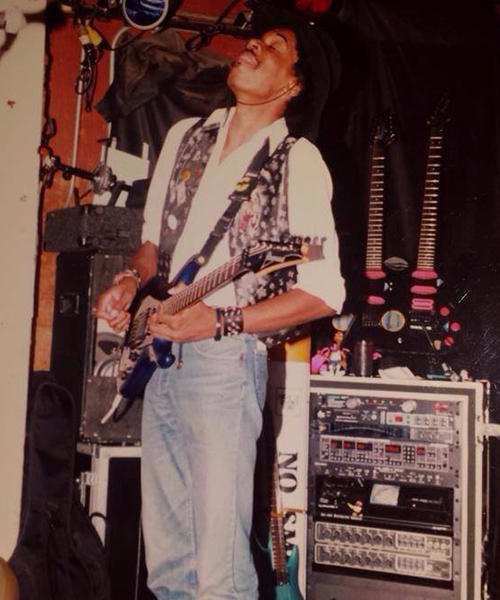 Larry Mitchell, circa 1989
Larry Mitchell, circa 1989
And the other thing was later on… I was playing my music in 1988, 1990 -91 -92, and I remember my drummer was Yves Gerard. He was getting married, and I said, “Do you want to cancel some of these gigs before it's too late? Because I don't like the canceled gigs at the last minute.” And he's like, “No no, I could do it!” And I said, “Yves, you’re getting married!” and he goes, “No, I can do it!” And then, right before the wedding, we had some gigs, and he called me, “I'm so sorry, I can't do the gig; it's just too crazy.” I said, “Oh, Yves, well, you know, I understand...” And he goes, “Don't worry, I got Tal Bergman. He's going to do it.” I'm like, “Who's Tal Bergman?” Well, Tal Bergman played with Billy Idol, Belinda Carlisle, Rod Stewart, and Simple Minds... Tal Bergman played with everybody, and he’s a ridiculous drummer. Great, great, great drummer. So Tal calls me and goes, "I can't make it to the rehearsal, but I'll have this stuff when I get there.” I'm like, “All right, whatever...” You know, I can't cancel now... Killed it. Absolutely just amazing. Played great. No rehearsal. Great. After the gig, he goes, “Hey, I know I'm supposed to do this other gig, but I can't make that, but I just called a friend of mine, Graham Hawthorne. He's going to do it,” and I'm like, “OK...” Graham was ridiculous even more, just never had a rehearsal. Didn't even do a sound check. Showed up at the gig, house drum kit, tuning the kit, and I was like, “Is he going to just warm up? No. All right.” He goes, “All is ready?” And I am like, “Sure! Count it off!” And the gig was just phenomenal. But the thing that really was great was that none of those guys tried to stab Yves in the back and take the gig.
And I took it for granted because I learned that there were a lot of great drummers and musicians that I knew would be like, “Hey, I can't do this gig, but a friend of mine can do it.” And as the artist, you're thinking, “All right, I trust you.” That's what happened there in New York, “I trust you.” And then the person trying to sub out the gig trusts the person they subbing would not try stabbing back and go, “Hey, you should really have me play this gig full time because so-and-so is not good at this.” And when I say I took it for granted, when I moved, that was not the case. It was like musicians stepping over, musicians trying to badmouth them and to get any kind of gig. That was like, “Oh, let me take this gig from so-and-so.” And I wasn't used to that at all.
So that camaraderie and great musicianship, I'm talking absolutely great musicianship. And people just think when I try to follow that, and I still try to follow that. When I got a call for the Billy Squier tour to audition for the first time, I called a handful of guitar players I knew and said, “Hey, this is the management company. I just got a call for this Billy Squier audition. They're probably still checking people out. You should call.” And only one person was like, “Why are you telling me you don't want the gig?” I said, “Yeah, I want the gig, but if I don't get the gig, I would prefer that one of my friends gets the gig, you know?” And then, “You know, hopefully, you'll recommend me for all the gigs in town you can't do because you're on the road.” And he didn't; that one person didn't quite get it, and he was from out of town. A lot of times people will come from out of town, and they didn't get it. They would try to do what they’d normally do. And that didn't last long. I'd say, from 1985 to 1995, for sure. You didn't last long in New York City with the core group and players if you were trying to steal gigs from people.
GA: As a kid, you started to play drums. What made you switch to a guitar, and was the Limelight guitar solo contest a pivotal moment in your professional career, or was it your 1988 tour with Spanish/Italian artist Miguel Bosé?
LM: I had a toy drum kit as a kid, and a toy guitar, too, and we lived in Brooklyn in an apartment on the third floor. And my mom was trying to watch TV, and I kept hitting the drums and she kept saying, “Don't hit the drums now - I'm trying to watch TV,” and I was like, “OK.” And I think I was probably seven or eight, maybe almost nine, and to that age group, five minutes is like an eternity, so I start hitting the drum kit, and she goes, ”I told you don't hit the drums, and I'm trying to watch TV!” I did it again. She goes, “If you hit the drums one more time, I'm throwing them out the window!” And after a while, I hit the drums and she threw them out the back window in the backyard. And so that left me with a guitar.
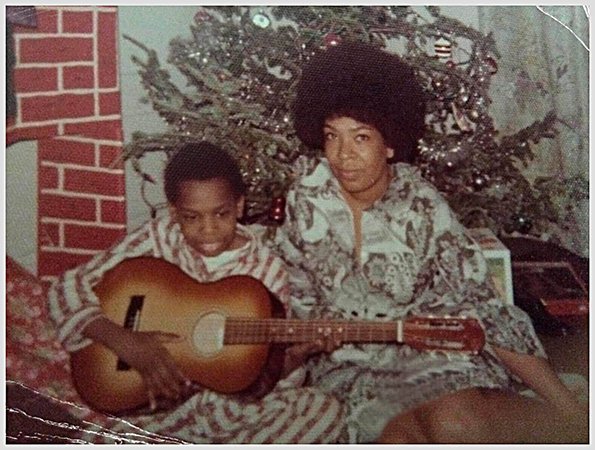 Photo: larrymitchell.com
Photo: larrymitchell.com
GA: What a rock and roll story, really! So rock and roll!
LM: And then the Miguel Bosé tour was my first big tour. Yeah, it was actually my first tour period. First, anything traveling outside of New York State or actually New York City, Long Island. And it was great Carmine Rojas from David Bowie, Rod Stewart, and Patti LaBelle. He put together the band, and the drummer was Alan Childs from David Bowie's Glass Spider tour and Julian Lennon, and Warren McRae - the bass player who played with Tina Turner and a bunch of other artists. It was great to have those guys on the road with me and teach me the ropes. It was amazing to go to another country and just to see what that was like, and it gave me a hunger to travel to start with, you know, Italy and Spain.
And Miguel's audience, I mean, the Seville show, was 90,000 people, which was amazing. I only played in clubs then and had no idea what the largest club I played in up until that time, maybe 500 people or something like that. And then you are on a stage where you can’t hear the person on the other side of the stage. You can’t hear the person next to you if everybody's yelling and screaming and clapping and stuff. But we didn't have any in-ear monitors back in those days, so it was unique. But yeah, it was great. Miguel was great, and it was a wonderful time.
GA: Your very first self-titled LP features a very impressive line-up of musicians. Can you describe the music style of that album and how you managed to put it all together at such a young age? Even though I’ve got an idea now because of your experience with Miguel, I’d like to hear that from you.
LM: Well, that first record had the rhythm section, which is most of the rhythm section that I played live with. We changed bass players right before the record. Gary Kelly was the bass player. Jimmy Fury came into play. And then Mark Epstein came in and played on the first record.
Just people I knew, just people I knew. Dave Wittman was a great producer and engineer and his credits are just insane. And so I learned a lot by working with Dave on that record.
(David Wittman's credits include KISS, Peter Frampton, Eric Clapton, Richard Marx, Billy Idol, Bad Company, Dave Stewart, Trans-Siberian Orchestra, Foreigner, and many others, - Ed.)
The Crunch "I'm a Believer" 1992 Black Rock Christmas
GA: What are the stories behind The Zebra Jacket and the double neck Ibanez that we can see on the cover of that (Larry Mitchell's 1990) album?
LM: Well, I'll go backwards about the Zebra Jacket. Before I left for the Miguel Bosé tour, I was in a band called the Rhythm Team with this guy, Steve Missal, who used to play with Ted Nugent and Billy Idol. There were three drummers, a bass player, a keyboard player, me on guitar, five background singers, and a horn section. A lot of people. And one day we were playing at a club called Club Nirvana in Manhattan, where the ball drops every year on New Year's Eve. And one of the background singers walked in wearing that coat and she's much shorter than me, or I'm much taller than her. So it was a full-length coat on her, and I was like, “That coat! That's amazing.” And she goes, “Thank you.” I said, “Can I try it on?” And she's like, “What?” And I said, “Can I try it on?” So I tried the coat on, and it was like, “Oh, it fit me perfectly!”
It didn't go all the way down to the floor, but it would be perfect. So she goes, “Well, it looks rainy. You can wear it for the show.” So I wore it for the show, and it was great, and then I kept thinking about it, and I said, “Can I buy it from you?” She told me how to find another one, but I couldn't find it, so I ended up getting the coat from her. And I did not wear it on the Miguel Bosé tour. But after I came home, I started wearing it, and then I took pictures with it and without it. And those are the ones that with it on me, you know, stayed for the cover. And then I had to promote the record and I was playing shows even in the summer in New York City; it was hot in that coat because it was a winter coat. It was pretty wild…
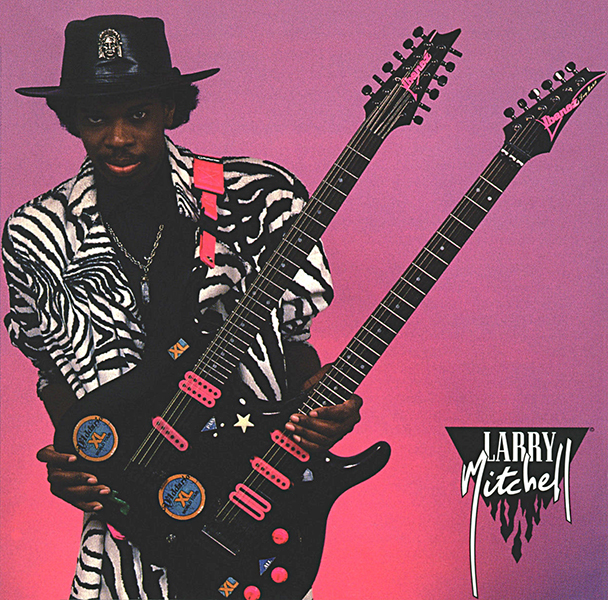 Larry Mitchell, self-titled debut album, 1990
Larry Mitchell, self-titled debut album, 1990
The Double-Neck Ibanez Story.
By 1987, I had won in the New York City Limelight Guitar Solo contests two years in a row. And I got a call from Steve Blucher at DiMarzio pick-ups, and he said that it was a company, which I'm not going to name, that had been doing what Ibanez was doing, which was taking lesser known local guitar players and putting the spotlight on them and giving them endorsement and working with them. And so that's what this company was trying to do. And he sent them something of mine and they wanted to work with me.
I went to the NAMM show. I had to sell the guitars that I won in order to pay to get to the NAMM show. And we went to that company and had a meeting, and they wanted me to play a very specific guitar, which I did not like at all. And I said to them, " I can't play this guitar. " I don't think I could put my name on it, but they say, “Well, we can make it work.” I said, “Yeah, but I don't like the guitar and the way it looks. It wasn't right for me at all. And he goes, “Well, OK… But this is a large company. You know, if you play this guitar for a while, it’ll probably get this continued. And then you’ll be one of the artists who would switch to one of their other guitars.” I was like, “I can't put my name on this guitar.” And he goes, “OK,” and as we were leaving that company, he goes, “Did you say you sold your guitars?”
I sold them. I had two guitars left. They were not great guitars. But finally, I got two really good guitars from winning a solo contest, which is the only reason I entered the contest in the first place, but I wanted a real, high-quality guitar. And he goes, “You told me you sold the guitars?” I said, “Yeah,” he goes, “Alright, I'll make you something. So you have a guitar for a while.” But as we were talking about this, we passed by Ibanez, and I said, “What about Ibanez?” He goes, “Oh, they're not doing that anymore. They are not looking for any unknown players, and they're looking for big names.” So I said, “Can we at least give it a shot?” He goes, “Sure.”
So we walked over, we met Richard Lasner from Ibanez at the time and shook his hand, gave him a press kit and stuff. And that was it. And I walked away thinking like, “Oh, I really did mess up an opportunity because it was very light: “OK, great. Nice to meet you.” And then later that night or the next day, I ran into Richard Lasner in the elevator at the NAMM Show and I said, “Hey, Richard, you remember me?” And he goes, “Yeah, yeah.” And because I'm starting to worry now that I don't have any guitars, I go, “Can you please tell me, what are the odds of me actually getting it? Are you picking artists for endorsement?” He goes, “Well, to be honest with you, we only usually make one decision at the NAMM Show, and then we go back two weeks after the NAMM Show, and we sit down, and we go through all the press kits, and we go to who we think is a good pick.” And I said, “So if you only have one person to pick if you only get a chance to listen to or review one person at the NAMM Show, could you do that with me?” And he goes, “I couldn’t do that!”
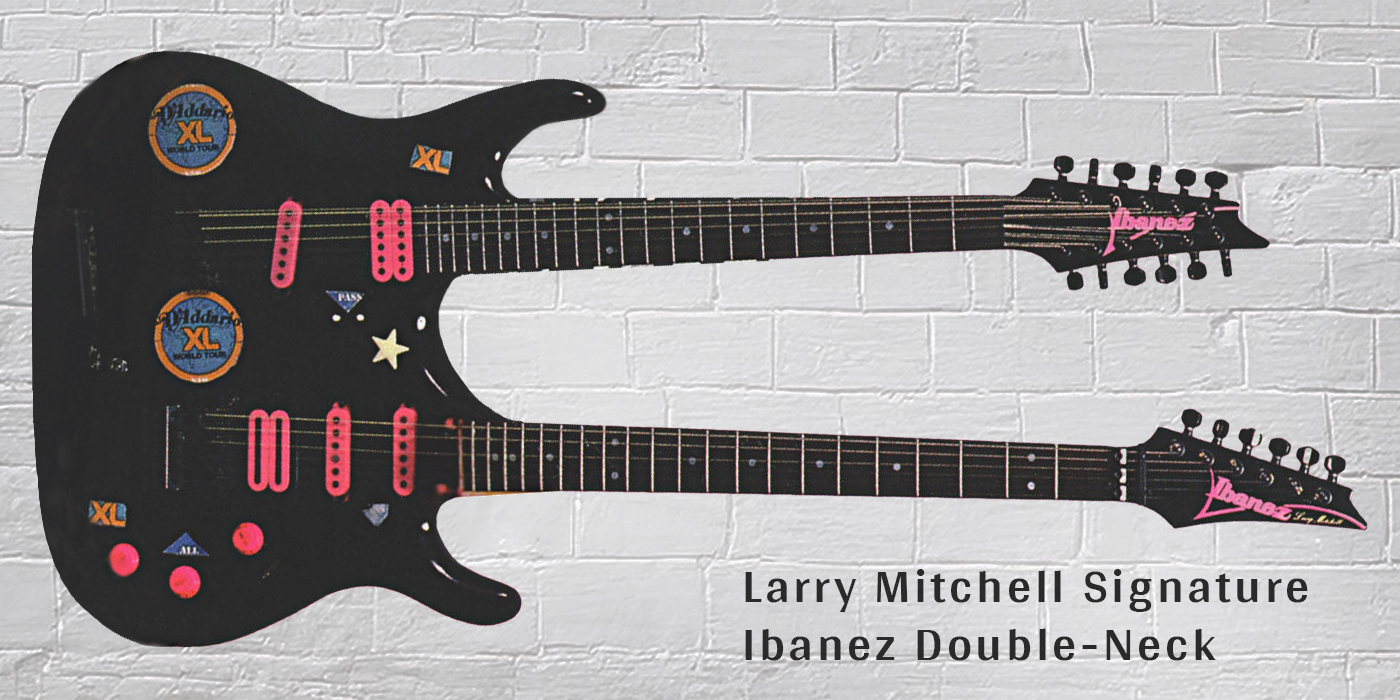 Larry Mitchell Signature Ibanez Double-Neck, 1990's
Larry Mitchell Signature Ibanez Double-Neck, 1990's
So the next day, I went to the NAMM Show, and I was supposed to meet Steve and walk around and look at other companies because I was really panicking because I didn't have any guitars. And I pass by Ibanez, and I see Rich early in the morning looking through a magazine, and I decide to just walk by and say “hello”. I wasn’t going to bug him; I just wanted to say hello… And as I'm walking, I realize he's reading the Guitar World magazine that I'm in for winning the guitar solo contest. And as I got there, it was perfect timing. He turned the page, and I went, “Hi Rich!” He went, “Hey, hey!” And the page he turned to was one that I was on for winning the guitar solo contest.
He goes, “I did listen to your package, and, you know, I really enjoy what you're doing. We'd like to work with you.” And that was it. And I was like, “OK.” It was a guitar company that I had played some guitars at a music store, so I enjoyed that. Anyway, they gave me an endorsement of what was kind of considered a local endorsement. I went and picked up the guitar. I think in March or April, I got the Miguel Bosé tour, and I told them, “Hey, I got this tour; I'm going to do it. It's in Italy, Spain.” And he called me, he said, “Why don't you come in? You can't take one guitar on the road.” So he gave me some more guitars, and they treated me wonderfully. And then, while I was on the road in Spain and Italy, I stayed in contact with Rich, and he said, “Do you need anything?” I said, “No, no, everybody's taking care of me here. I got three guitars that I brought over, which are great. The Ibanez people in Italy came and made sure everything was fine. They were really nice. He goes, “Well, is there anything you just want in general?” I said, “I've always wanted a double neck.” He goes, “All right, when you get off the road, come on in, and we'll sort out a double neck for you.” And I was like, “Oh, okay.”
And when I got off the road, I took the train, and I went there and they said, “Well, meet Jim Donahue and Mace Bailey.” Mace Bailey had built Steve Vai's triple-neck guitar. And it was the first multi-neck guitar I think he built. He goes, “I've never built the double neck before. How far do you want the necks?” So they built it to my specs, which was not the best idea because I had no idea. And so the necks go sort of being like this, like that to give me space, which makes the massive big guitar - massive, makes the body of the guitar just huge.
I looked at that and then went, “Oh!” because I don't want to lift my double, and I still have my double, and I don't want to lift that! I can't imagine how heavy that guitar is. And my double neck has one of Steve Vai's necks on it. Before they came up with the seven-string for Steve, he had to make a couple of d-necks. So it's two frets lower than where on the neck a zero fret is. And then he has the other two on. There are two triple-neck guitars. He has one on each of those, and the third one was an extra. And I saw it there and said, “Hey, can you put that on my double neck?” And they were like, “Well, we'd have to get permission from Steve.” And Steve was like, “Sure.” So it's a d-neck guitar.
 Vai Academy 01.2018 - Tearing it up and having fun in the Ultra Zone!
Vai Academy 01.2018 - Tearing it up and having fun in the Ultra Zone!
Vai Academy 01.2018 - Tearing it up and having fun in the Ultra Zone!
Vai Academy 01.2018 - Tearing it up and having fun in the Ultra Zone!
 Vai Academy 01.2018 - Tearing it up and having fun in the Ultra Zone!
Vai Academy 01.2018 - Tearing it up and having fun in the Ultra Zone!
Vai Academy 01.2018 - Tearing it up and having fun in the Ultra Zone!
Vai Academy 01.2018 - Tearing it up and having fun in the Ultra Zone!
 Larry Mitchell jamming with Steve Vai on the Inviolate Tour. 11.2022
Larry Mitchell jamming with Steve Vai on the Inviolate Tour. 11.2022
Larry Mitchell jamming with Steve Vai on the Inviolate Tour. 11.2022
Larry Mitchell jamming with Steve Vai on the Inviolate Tour. 11.2022
 Larry Mitchell jamming with Steve Vai on the Inviolate Tour. 11.2022
Larry Mitchell jamming with Steve Vai on the Inviolate Tour. 11.2022
Larry Mitchell jamming with Steve Vai on the Inviolate Tour. 11.2022
Larry Mitchell jamming with Steve Vai on the Inviolate Tour. 11.2022
 Larry Mitchell jamming with Steve Vai on the Inviolate Tour. 11.2022
Larry Mitchell jamming with Steve Vai on the Inviolate Tour. 11.2022
Larry Mitchell jamming with Steve Vai on the Inviolate Tour. 11.2022
Larry Mitchell jamming with Steve Vai on the Inviolate Tour. 11.2022
 Larry with the triple neck Hydra. Opening for Steve Vai. 11.2022
Larry with the triple neck Hydra. Opening for Steve Vai. 11.2022
Larry with the triple neck Hydra. Opening for Steve Vai. 11.2022
Larry with the triple neck Hydra. Opening for Steve Vai. 11.2022
 Larry Mitchell Jamming with Paul Gilbert and Band
Larry Mitchell Jamming with Paul Gilbert and Band
Larry Mitchell Jamming with Paul Gilbert and Band
Larry Mitchell Jamming with Paul Gilbert and Band
 Larry and George Lynch. Dallas International Guitar Festival. 05.2021. Photo: 1AnitrasDance
Larry and George Lynch. Dallas International Guitar Festival. 05.2021. Photo: 1AnitrasDance
View the embedded image gallery online at:
Larry Mitchell jams with Steve Vai, Paul Gilbert, George Lynch
Larry and George Lynch. Dallas International Guitar Festival. 05.2021. Photo: 1AnitrasDance
Larry and George Lynch. Dallas International Guitar Festival. 05.2021. Photo: 1AnitrasDance
View the embedded image gallery online at:
Larry Mitchell jams with Steve Vai, Paul Gilbert, George Lynch
https://suleyera.com/music-life/rock-prog-metal/larry-mitchell-life-and-music.html#sigProId3f8195214d
GA: After Larry Mitchel's album, your career skyrocketed with your work with Ric Ocasek’s (The Cars) FireBall Zone Cd and appearance in the music video “Rockaway,” followed by touring with Billy Squier and Tracy Chapman. Can you describe, in short, the personalities of Ric, Billy, and Tracy and your relationships with them? What were the most significant moments, collisions, and how work with such artists influenced your own music in the later years?
LM: Working with Ric was a dream. Nile Rodgers produced it, and he's the one who asked me to come into play on one song. Ric later invited me to his house and then asked me to play on the rest of the record. And we were going on tour, on a big tour and stuff like that, but only to promote stuff. Rick and his wife at the time, Paulina Porizkova, were two of the nicest people I think I've ever met. They were just upbeat and wonderful, and as we recall, Ric gave me great management advice. And shortly after that, I actually did have a problem with managers and that turned into really good advice.
Billy Squire. I auditioned for Billy Squire in 1989. I didn't get the gig because I wasn't right for the band at the time, but Billy and I stayed in contact, and actually, the whole band stayed in contact with everybody, and I wasn't disappointed. I mean, I was a little bit disappointed that I could use the tour, but it just wasn't the right time, and it was great. I enjoyed hanging out with those guys, and then in 1991, I ran into them in a club, and they were looking for a guitar player: “Hey, no, we're done looking for the guitar players, and you're coming on the road with us.”
Billy introduced me to the world of vintage guitars because he took a ‘58 Les Paul, two ‘57 Gold Tops, and a Nocaster. He took vintage guitars on the road and I was not exposed to that. I wish I were more into vintage guitar than that, as I am now. And it was just really good to watch him deal with tone and understanding. Everything I learned from Billy came in, and it really sunk in about 10 years later. So I remember that, and I appreciate that. By the way, Billy is also really great. I mean, he is a great guitar player, but what really struck me was how funky and solid his rhythm guitar playing was. I was really impressed at that, and he could definitely solo, but I was just, like, blown away.
Tracy is one of the most amazing, consistent, accurate guitar players and artists I've ever met. She plays the same, almost like it's a machine - the same every night, no matter what the condition is. And her accuracy was just amazing. Touring with Tracy was really nice because it was just like one of the first times that I could come to a show and always cool down. And we got on the tour of all the many places where I had not been before, and she was great to hang out with. Really great.
 Larry Mitchell in his "Zebra" jacket with Billy Squier, 1990
Larry Mitchell in his "Zebra" jacket with Billy Squier, 1990
Larry Mitchell in his "Zebra" jacket with Billy Squier, 1990
Larry Mitchell in his "Zebra" jacket with Billy Squier, 1990
 Larry Mitchell with Billy Squier, 1991
Larry Mitchell with Billy Squier, 1991
Larry Mitchell with Billy Squier, 1991
Larry Mitchell with Billy Squier, 1991
 Larry Mitchell with Billy Squier, 1991
Larry Mitchell with Billy Squier, 1991
Larry Mitchell with Billy Squier, 1991
Larry Mitchell with Billy Squier, 1991
 Larry Mitchell with Ric Ocasek (The Cars), 1991
Larry Mitchell with Ric Ocasek (The Cars), 1991
Larry Mitchell with Ric Ocasek (The Cars), 1991
Larry Mitchell with Ric Ocasek (The Cars), 1991
 Larry Mitchell with guitar tech Mike on Tracy Chapman tour, 1992
Larry Mitchell with guitar tech Mike on Tracy Chapman tour, 1992
View the embedded image gallery online at:
Larry Mitchell touring with Billy Squier, Ric Ocasek (The Cars), and Tracy Chapman
Larry Mitchell with guitar tech Mike on Tracy Chapman tour, 1992
Larry Mitchell with guitar tech Mike on Tracy Chapman tour, 1992
View the embedded image gallery online at:
Larry Mitchell touring with Billy Squier, Ric Ocasek (The Cars), and Tracy Chapman
https://suleyera.com/music-life/rock-prog-metal/larry-mitchell-life-and-music.html#sigProId01936cb276
GA: When and how did you expand your creative work as a producer-engineer, which was recognized by 26(!) New Mexico Music Awards in various categories - from Pop, Adult Contemporary, Rap, and Rock, to Country and Native American? How did you stretch yourself to that next level?
LM: I learned a lot of engineering and producing on my third record, which was done in my friend's basement. I got to call a lot of people and asked them, “How do I do this? How do I plug in this? How do I do that?” And I got the bug for doing my own records at that point. And then I moved to San Diego, California, and I was working on my record and I would run into singer-songwriters. They were like, “Oh, you have a studio? Can you help me work on one of my own songs?” So I agreed to work on several people's single songs because it still was expensive to do that in a studio, and not a lot of people had home studios at the time.
So I started working with people, and they needed help with different things. I enjoyed the production part. I enjoyed playing a lot of the different instruments and programming and stuff. And so I worked on songs for other people for their records. And then, I think it was about a year later, most of them kept coming back and saying, “Hey, I like what you did on the single,” and it was much better than what they were experiencing at other places working with different people.
Then, they wanted me to do the whole record. So, all of a sudden, I thrust into trying to do three or four records for other people at the same time, which I had no idea how daunting that was. A whole record, you know, ten songs or more, is just insane. I know that now, but I did and that led me to move back to New York City and work for my friend Jeff Coplan and the Berman Brothers and do some different things. And then, I was producing independent artists as well. And then I moved to New Mexico to work with an artist. I had produced her record in San Diego. And once I was there, I kept getting asked to work with different singers and songwriters and stuff like that because I work with a lot of different people as I am the band, so I play whatever instruments they don't play. And then there were lots of different styles of music. So, you know, we started entering stuff in the New Mexico Music Awards, and then we started winning awards, and then I started entering things that I worked on production-wise and I won my Grammy in New Mexico.
I won the 26 New Mexico Music Awards in ten years working there, and there are only three or four of those that are with me as an artist. The rest are as a producer or engineer. The San Diego Music Award is for me as an artist. There were a couple of awards there for me as an artist, but just about then, I did a lot of production in world music, rock, adult contemporary, contemporary Christian, gospel, R&B, Native American, and lots of Native American stuff. So it was a learning. It was definitely a learning experience because people wanted to work with me, not for a specific style, but just because they had a good experience and worked in a great studio. So it's like, “What kind of record do you want to make?” It was eye-opening, and it's cool.
GA: In 2007, you won a Grammy Award for producing, engineering, and performing on “Totemic Flute Chants” by artist Johnny Whitehorse, who is better known as Robert Mirabal of Taos Pueblo. What did this work mean to you, and on which tracks can we hear your guitar?
LM: I actually don't remember if there's any guitar in it. I don't know for sure. I don't remember which one it is because I'm doing everything: I'm producing and engineering. I'm not playing the flute, but I'm playing keyboards. I'm playing lots of percussion. If there's bass on it, I play bass on it. If there's a piano, I play piano. I don't think there's any drum kit. There's definitely lots of percussion, but I don't think there's any drum kit. It's only me and Robert Mirabal because there's nobody else on it.
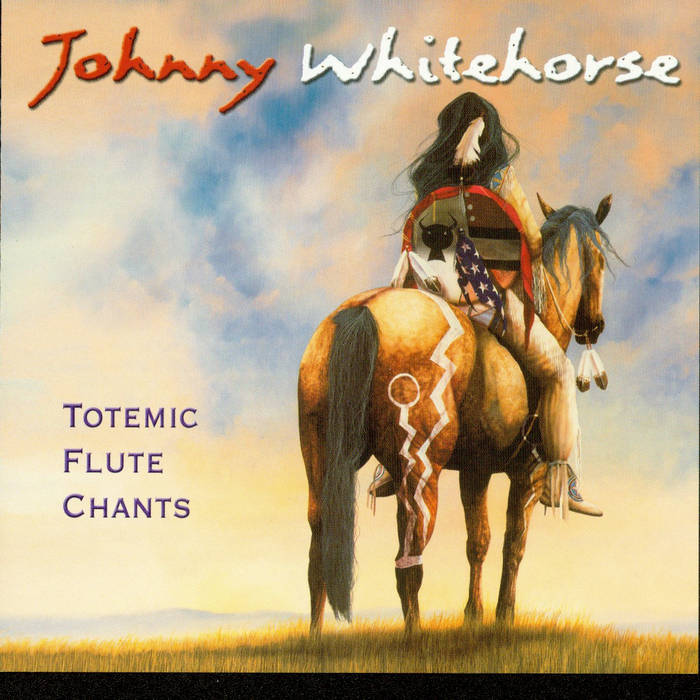 Johnny Whitehorse - Totemic Flute Chants
Johnny Whitehorse - Totemic Flute Chants
Grammy Award Winner for Best Native American Music Album
GA: And what can you share about the meaning, the spirit of that work?
LM: It was great. Johnny Whitehorse is actually a Native American artist named Robert Mirabal, who I put in the category, normally as like a crossover between the Doors and U2. So I played in Robert's band from 2002 to 2014, and his record company wanted him to go back to his original roots and make a semi-traditional-sounding Native American flute CD. We agreed to do three records, and I was going to produce and engineer for him and put it all together and stuff, and it was learning again, it was a big learning.
The first one was in the first round for the Grammys and the second won a Grammy, and the third one was nominated for a Grammy but didn't win. But I didn't do it thinking anything like that. The Grammys were nowhere near on my radar. It never was ever on my radar. So when they said, we want you to make a flute CD, I was like, what's involved in making a Native American flute CD, I had no idea. So I’d try to listen to a couple of things, and I still come from a pop background, so I like certain pop elements. Robert made a flute CD for pop, but it was not like this. So they said, just make it however you want.
And so I made what I consider a more pop-ish Native American flute CD the first time, and the record company loved it. Robert actually loved it, too. And then we kind of came upon the second one, and we did the same thing. Did a lot of things. So, I tried to add a few more elements to it. Again, it was a learning experience about how to get the sounds I wanted. When I teach, when I go speak at colleges about engineering or production, I bring up one of those CDs, if not all. And so we did things like I wanted the sound of drums, big drums, but in the distance. So, as far as engineering, you roll all the high-end off. I would record a little Native American drum about so big and hit it. You have to filter it and get it to be low. And then I would just roll all the high end with no treble off, add massive canyon reverb, and it sounded bigger. It sounds like it was a really big drum, long, far away, and stuff like that. And so that was a learning experience of how to get those sounds. You have to filter it and get it low.
I guess if I was making a pop record, this is what I would do. And to how I make the flutes, stuff like that. So, it was a good engineering learning lesson. And it was a good lesson. And then I remember sending it to the record company again. And it didn’t sound like the other Native American records that they have on their label. I think they might have hated it and they loved it. So it was cool.
GA: I love it too and I can add to it my subjective experience listening to it. It has a lot of volume and clarity at the same time, which makes it amazing from the sound perspective. And musically, I can hear influences of that music in your later work.
LM: Yeah, sure. I think that record got me to do Shelley Morningsong’s first record, which was a Native American folk-pop record. And there's a lot of the same kind of elements that I put into that record as well. But on Shelley's record, I got to play the drum kit on almost every song. There are lots of electric guitars and acoustic guitars. Lots of heavy bass proves there are a lot more instruments, not more modern instruments, on top of all the traditional sounds and stuff like that. So it's cool.
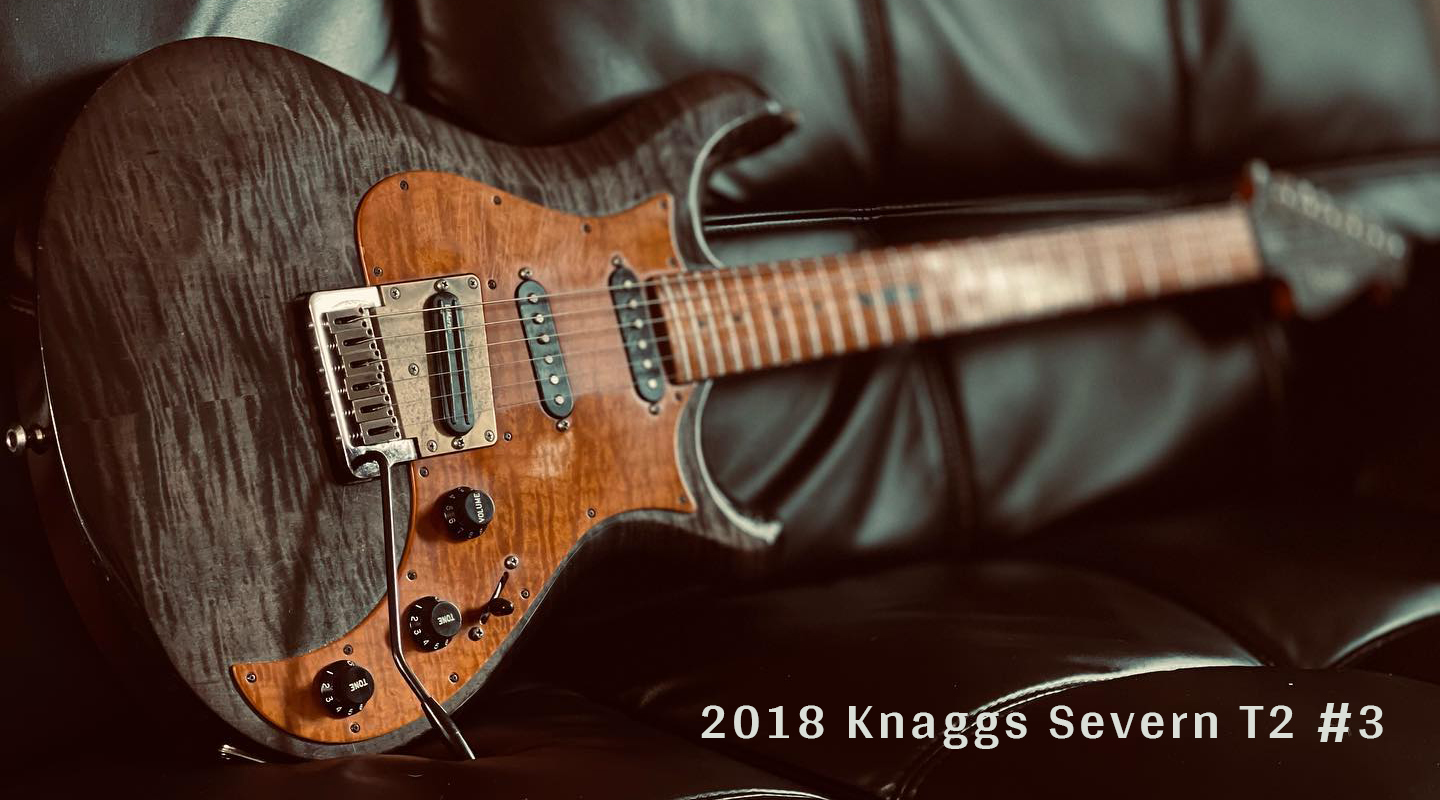 2018 Knaggs Severn T2 #3
2018 Knaggs Severn T2 #3
GA: Among guitar players, there is a constant battle over the eternal question: custom guitars versus mass production instruments. What is your personal experience with luthier-built Knaggs Guitars in comparison with other guitar brands, like Godin, Ibanez, and others?
LM: I am in a unique position because when I was with Ibanez I had some stock guitars, but they actually have a custom shop that makes guitars just for artists and they're hand-built in L.A. So that's like a custom shop guitar is…
GA: Right, but we are talking about arguments about luthier custom guitars, that they're overrated. They're too expensive. That the mass production guitars sound the same because the pickup is just a pickup, that sort of thing.
LM: No, there's something about someone going to pick out the wood for your guitar. And then, every step of the line, if it's not the same person, then it's a team of people that specialize in putting their hands on the guitar and making it as special as possible, putting the love into each instrument.
And so I left Ibanez after 26 years and now I'm with Knaggs Guitars. They make my electric guitars and it’s a small company as eight people work there. And Joe Knaggs, the master builder that touches every guitar. And I get to say there is a difference.
Also on the other side, you know, I play Godin guitars. They're not hand-built. I don't think they have a custom job. I know mine are off the assembly line, but they're made in Canada. It's very consistent. Once you get the quality together and maintain that, it's going to be a really good guitar.
But, you know, just in general, like a mass-produced guitar where they're cranking out 1000 in a week or a month, they're not inspecting each guitar. There's that level of care that's missing. So you might get a couple of those guitars that play amazingly and stuff like that. But in general, they usually need some sort of tweaking afterward. So, I'm a little spoiled right now.
 Larry Mitchell at the WYO Theater, 05.2021. Photo: Schreffler Media
Larry Mitchell at the WYO Theater, 05.2021. Photo: Schreffler Media
Larry Mitchell at the WYO Theater, 05.2021. Photo: Schreffler Media
Larry Mitchell at the WYO Theater, 05.2021. Photo: Schreffler Media
 Larry Mitchell. France - Live in Montbazon 04.2024
Larry Mitchell. France - Live in Montbazon 04.2024
Larry Mitchell. France - Live in Montbazon 04.2024
Larry Mitchell. France - Live in Montbazon 04.2024
 Larry Mitchell. France - Live in Montbazon 04.2024
Larry Mitchell. France - Live in Montbazon 04.2024
Larry Mitchell. France - Live in Montbazon 04.2024
Larry Mitchell. France - Live in Montbazon 04.2024
 Larry Mitchell. France - Live in Montbazon 04.2024
Larry Mitchell. France - Live in Montbazon 04.2024
Larry Mitchell. France - Live in Montbazon 04.2024
Larry Mitchell. France - Live in Montbazon 04.2024
 Larry Mitchell. Australia - Gympie Music Festival. 08.2023
Larry Mitchell. Australia - Gympie Music Festival. 08.2023
Larry Mitchell. Australia - Gympie Music Festival. 08.2023
Larry Mitchell. Australia - Gympie Music Festival. 08.2023
 Larry Mitchell. Strings Attached: The West Australian Guitar Fest, 10.2023. Photo: David Dare Parker
Larry Mitchell. Strings Attached: The West Australian Guitar Fest, 10.2023. Photo: David Dare Parker
View the embedded image gallery online at:
Larry Mitchell Live On Tour
Larry Mitchell. Strings Attached: The West Australian Guitar Fest, 10.2023. Photo: David Dare Parker
Larry Mitchell. Strings Attached: The West Australian Guitar Fest, 10.2023. Photo: David Dare Parker
View the embedded image gallery online at:
Larry Mitchell Live On Tour
https://suleyera.com/music-life/rock-prog-metal/larry-mitchell-life-and-music.html#sigProId5cb6caf4b0
GA: Touring artists always have funny or exciting stories that happen to them in different parts of the world. I have heard some of your adventure stories at your shows, especially about the boat accident in Sweden and some of your cross-border escapades in Russia and Dubai.
LM: Just being in a country where you don't speak the language is a little intimidating to start with. And then, when something goes wrong, it's a little crazy. In Sweden, the promoter wanted me to go with the main artists to get into a canoe and take pictures on the water. And I don't swim, and the canoe tipped over after a while, and I panicked. If my head goes underwater, you really want to knock me out if you’re going to save me. I would appreciate it if you could save me, but you want to knock me out because I'll take you with me.
I had a great time in Russia. The last show in this one trip was in Ekaterinburg, and the person who was supposed to be my translator and guide was a young kid who had just turned 21, and he was not translating. He was answering for me, which was a little frightening. At the border patrol, at the customs, don't answer for me. You know, they say something. You translate it into English for me. I'll give you an answer. You translate it back into Russian. Don't just go. Don't just answer for me because God knows what you're saying. I mean, the stories like that take too long for me to tell the whole story.
GA: Larry, you have a very big and open heart for children, and you regularly do workshops for autistic children who play musical instruments, in particular with Florida State University, the Center for Autism and Related Disorders, and Y Music in Cleveland, Ohio. What was your most amazing experience playing music with autistic kids, and what did you learn from that? What are their special musical talents, and what are the challenges you experienced during such workshops?
LM: Special abilities, music talents. It's random. It’s all over the place. So there are some that are gifted at playing guitar and some different playing piano. Some are just starting out, some connect, and there are lots of different ways.
There's a kid that I've met. He was twelve or thirteen at the time, maybe fourteen, and he knows two hundred Neil Young songs, chords, and lyrics. And when we played together, he corrected me because I played the wrong chord. He would stop the show to correct me. As a musician, I think that we share a bond with autism in the sense that they're hyper-focused usually, and as a musician or an artist, we tend to hyper-focus as well if we can’t come out of that. I know when I'm working on production or recording or working on guitar sounds, I am hyper-focused.
 Larry Mitchell at the FSU Center for Autism 02.2020
Larry Mitchell at the FSU Center for Autism 02.2020
Larry Mitchell at the FSU Center for Autism 02.2020
Larry Mitchell at the FSU Center for Autism 02.2020
 Larry Mitchell at the FSU Center for Autism 02.2020
Larry Mitchell at the FSU Center for Autism 02.2020
Larry Mitchell at the FSU Center for Autism 02.2020
Larry Mitchell at the FSU Center for Autism 02.2020
 Larry Mitchell at the FSU Center for Autism 02.2020
Larry Mitchell at the FSU Center for Autism 02.2020
Larry Mitchell at the FSU Center for Autism 02.2020
Larry Mitchell at the FSU Center for Autism 02.2020
 Larry Mitchell at the FSU Center for Autism 02.2020
Larry Mitchell at the FSU Center for Autism 02.2020
Larry Mitchell at the FSU Center for Autism 02.2020
Larry Mitchell at the FSU Center for Autism 02.2020
 Larry Mitchell at the FSU Center for Autism 02.2020
Larry Mitchell at the FSU Center for Autism 02.2020
Larry Mitchell at the FSU Center for Autism 02.2020
Larry Mitchell at the FSU Center for Autism 02.2020
 Larry Mitchell at the FSU Center for Autism 02.2020
Larry Mitchell at the FSU Center for Autism 02.2020
Larry Mitchell at the FSU Center for Autism 02.2020
Larry Mitchell at the FSU Center for Autism 02.2020
 Larry Mitchell at the FSU Center for Autism 05.2017
Larry Mitchell at the FSU Center for Autism 05.2017
Larry Mitchell at the FSU Center for Autism 05.2017
Larry Mitchell at the FSU Center for Autism 05.2017
 Larry Mitchell at the FSU Center for Autism 05.2017
Larry Mitchell at the FSU Center for Autism 05.2017
Larry Mitchell at the FSU Center for Autism 05.2017
Larry Mitchell at the FSU Center for Autism 05.2017
 Larry Mitchell at the FSU Center for Autism 05.2017
Larry Mitchell at the FSU Center for Autism 05.2017
Larry Mitchell at the FSU Center for Autism 05.2017
Larry Mitchell at the FSU Center for Autism 05.2017
 Larry Mitchell at the FSU Center for Autism 05.2017
Larry Mitchell at the FSU Center for Autism 05.2017
Larry Mitchell at the FSU Center for Autism 05.2017
Larry Mitchell at the FSU Center for Autism 05.2017
 Larry Mitchell at the FSU Center for Autism 05.2017
Larry Mitchell at the FSU Center for Autism 05.2017
View the embedded image gallery online at:
Larry Mitchell at the FSU Center for Autism
Larry Mitchell at the FSU Center for Autism 05.2017
Larry Mitchell at the FSU Center for Autism 05.2017
View the embedded image gallery online at:
Larry Mitchell at the FSU Center for Autism
https://suleyera.com/music-life/rock-prog-metal/larry-mitchell-life-and-music.html#sigProId2a9bc632fe
One of the most unique experiences that happened to me was on the road before I ever got involved with working with autistic kids. This was one of the things that helped me glued to it - I was invited to a house after a show as a sideman, and the lady of the house said, “You know, my son plays guitar, which you know, he would love to meet you. Would you sit down to maybe play something?” And I said, “For sure.” So it took forever to get him out of the room. He came out. And my first impression of him, because there was no warning of anything or heads up or anything, was that he was the oddest kid I had ever met. He was just different. And then she said to him, “Why don't you take Larry in your room and play guitar with him?” And he said, “OK,” but he didn't get up from the table right away. I stood up, and he stayed there for a while longer.
So we made it into his room. He picks up the guitar. I pull out my guitar, and I start playing something. He goes to play something, and he has a wildly out-of-tune guitar. None of the strings were really in tune. It sounded like they were just off. And I said, “Your guitar is out of tune. Would you like a tuner?” And he shut me out. I didn't exist anymore. He was just hitting every note on the guitar, every fret, every note on the guitar, and I would try and talk to him and he'd just ignored me the whole time I had a tuner, the whole bit.
And finally, his mother walked by, and she said, “Is everything cool?” And I said, “You know, is there something I should know?” And she looked and said, “No, it'll be alright, just give him a little time.” I'm like, “Okay.” So I'm just sitting there uncomfortable, and I started noodling, and after a while, I heard him noodle a little bit of what I just played. And I look up, and all of a sudden, he's back, and he's looking at me, and I exist, and I play something, and he plays something, but he's not playing it in the same spot. He's hitting the right notes, but he's bending here and there, and he's pulling another note, and he's just playing wildly all over the place. But he's playing kind of what I play, and I realized he was hitting every note because he knew something was wrong, but he relearned the fretboard. Because the guitar was out of tune instead of tuning the guitar, he said, “Oh no, this note is not here anymore. This note is this or this.” And he bends it a little bit.
That blew me away, and I was like, OK, I had never experienced that before, but that was amazing. Absolutely amazing. So, and then, everything else was just by accident. I would run into several people, and they said, “Well, what do you do?” And I thought, and I said, “Oh yeah, we work with kids with autism that, you know, play music really so well. You know, if there's something I can do to help, I can.” And then when I would be in that town, they would contact me and I started doing it. Then, it became more of a regular thing, and I would volunteer. In 2019, I was on the road all the time, and there was no time to do it, so they ended up asking for a grant to make sure that they were hiring me to be there to make sure I could come. I don't normally do it for money. I'd usually volunteer when I can because a lot of the organizations don't have the money to do stuff like that. But like I said, this particular time, they just wanted to make sure I was going to be there.
It's very cool, and it's very rewarding just to watch. For some reason, I've been able to get kids. It's a very individual kind of thing. So, a lot of times, you get kids to play solo. Getting them to play together is not always the easiest. So, I usually put on a show and get the kids to do a couple of things. One of the main things to do is put on a show and get the kids to play one song by themselves, one song with me. And then, at the end of the day, we all play something together. And when I can get them all to play together, all the parents are crying. I'm crying. It's amazing. It's really cool.
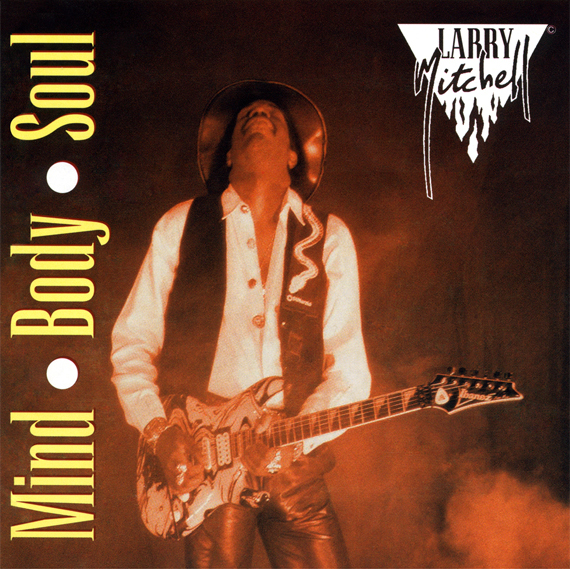 Larry Mitchell - Mind Body Soul, 1994
Larry Mitchell - Mind Body Soul, 1994
GA: Your 1994 album Mind Body Soul sounds like a logical development from your self-titled 1990 debut, which was much heavier. In Mind Body Soul, you charge listeners with dynamic, funky grooves and explore more sophisticated melodies, which can now be considered your signature style and sound that we can hear in your most recent work, like “Shadows on the Soul.” And, with another 2020 work, “The Light Within,” you go even further, presenting truly ethereal music full of beautifully crafted melodies, sounds, and harmonies. You now also dedicate some of your shows solely to the acoustic guitar. Do you plan to continue this trend of expressing two opposite sides of your creative personality, or you might surprise your fans with something even more different and novice?
LM: I had some of those mellow songs for the first record, but when we picked songs, we wanted to have a theme or vibe for that first record. And the second record, “Mind Body Soul,” was kind of self-produced pretty much with my friends who helped me make it, Mitch Diamond and so on. I had in excess of the mellowing I always write. I always wrote mellow songs, so I had an extra amount of those, and those are songs that have been playing a lot live.
So that's why that's different. That sound is different. The third record is my first acoustic record. It's called “Escape Acoustic Passages Volume One,” and it’s all acoustic guitar. That happened because I wrote those songs because I was in an apartment in Manhattan the size of a shoebox, and all my gear was in storage except an acoustic guitar and a little Yamaha sequencer. And it is probably one of my bigger selling records, and people would always bug me, “When is Volume two coming out?” And they know the response and record is great. And I was like, “Yeah, but I do more electric.” So what I had done was pretty much on almost all the records after that there's at least one or two acoustic songs.
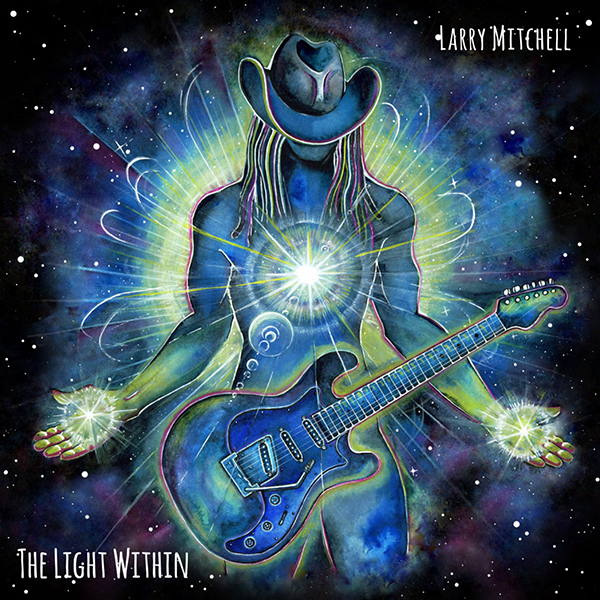 Larry Mitchell - The Light Within, 2020
Larry Mitchell - The Light Within, 2020
In 2020, I was working on music, and I had the whole record called “Shadows on the Soul,” and I had written a couple of acoustic pieces going on it just like I had on “The Traveler'' and records before that. The songs on “The Light Within” and the “Shadows On The Soul” are very opposite. So that's where I decided to make another electric and another acoustic, a whole acoustic record, and I'm happy I did. I don't know if I'll continue doing that. I'll probably do another record, but I'll probably always put an acoustic song or two on the next, on the other electric records as they come out as well.
Hopefully, I continue to grow as a musician. I can't tell you where that's going to lead me, but hopefully, I'll be doing some more different things and interesting things.


